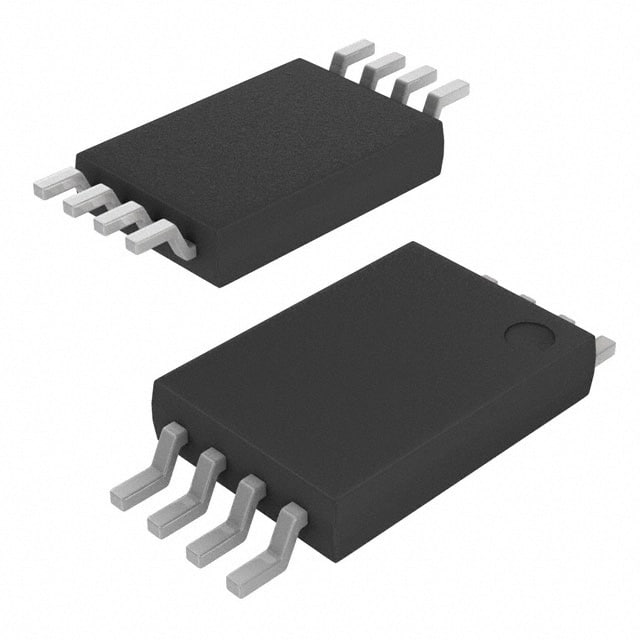Xem thông số kỹ thuật để biết chi tiết sản phẩm.

AT93C46-10TU-1.8-T
Product Overview
Category
AT93C46-10TU-1.8-T belongs to the category of electrically erasable programmable read-only memory (EEPROM) chips.
Use
This product is commonly used for non-volatile data storage in various electronic devices such as microcontrollers, computers, and consumer electronics.
Characteristics
- Non-volatile: Retains stored data even when power is removed.
- Electrically erasable: Allows for easy modification of stored data.
- Programmable: Can be written and rewritten multiple times.
- Small form factor: Compact size suitable for integration into various electronic devices.
Package
AT93C46-10TU-1.8-T is available in a surface-mount package, specifically the 8-pin SOIC (Small Outline Integrated Circuit) package.
Essence
The essence of AT93C46-10TU-1.8-T lies in its ability to provide reliable and flexible non-volatile data storage in electronic systems.
Packaging/Quantity
This product is typically packaged in reels or tubes, with a quantity of 2500 units per reel/tube.
Specifications
- Operating Voltage: 1.8V
- Memory Size: 1 kilobit (128 bytes)
- Organization: 64 words x 16 bits
- Interface: Serial I2C (Inter-Integrated Circuit)
- Maximum Clock Frequency: 400 kHz
- Data Retention: 100 years
- Endurance: 1 million write cycles
Detailed Pin Configuration
- Chip Select (/CS)
- Serial Clock (SCK)
- Serial Data Input (DI)
- Serial Data Output (DO)
- Write Enable (/W)
- VCC (Power Supply)
- Ground (GND)
- Not Connected (NC)
Functional Features
- Byte-level Read and Write Operations: Allows for efficient data manipulation.
- Software Protection: Provides security by allowing write protection of memory locations.
- Sequential Read: Enables sequential access to memory locations without the need for readdressing.
- Self-Timed Programming Cycle: Simplifies programming operations by eliminating the need for external timing control.
Advantages
- Low Power Consumption: Operates at a low voltage, reducing power requirements.
- Compact Size: Small form factor enables integration into space-constrained designs.
- High Reliability: Offers long data retention and endurance, ensuring data integrity over time.
- Ease of Integration: Compatible with standard serial I2C interface, facilitating seamless integration into existing systems.
Disadvantages
- Limited Storage Capacity: With a memory size of 1 kilobit, it may not be suitable for applications requiring large amounts of data storage.
- Slower Write Speed: The EEPROM technology used in this product typically has slower write speeds compared to other memory technologies.
Working Principles
AT93C46-10TU-1.8-T utilizes EEPROM technology, which allows for electrically erasable and programmable non-volatile data storage. It operates based on the principle of storing charge in floating gate transistors within the memory cells. The stored charge represents the binary data, which can be read, written, and erased electronically.
Detailed Application Field Plans
AT93C46-10TU-1.8-T finds application in various electronic devices and systems, including but not limited to: - Microcontrollers - Computers - Consumer Electronics - Automotive Electronics - Industrial Control Systems
Detailed and Complete Alternative Models
Some alternative models that offer similar functionality to AT93C46-10TU-1.8-T include: - AT93C66-10SU-2.7-T - CAT24C01WI-GT3 - 24AA1025-I/SN
These models provide comparable features and can be considered as alternatives based on specific requirements and compatibility considerations.
Word count: 511 words
Liệt kê 10 câu hỏi và câu trả lời thường gặp liên quan đến ứng dụng AT93C46-10TU-1.8-T trong giải pháp kỹ thuật
Sure! Here are 10 common questions and answers related to the application of AT93C46-10TU-1.8-T in technical solutions:
Q1: What is AT93C46-10TU-1.8-T? A1: AT93C46-10TU-1.8-T is a specific model of EEPROM (Electrically Erasable Programmable Read-Only Memory) chip manufactured by Microchip Technology. It has a capacity of 1 kilobit (128 bytes) and operates at a voltage of 1.8V.
Q2: What are the typical applications of AT93C46-10TU-1.8-T? A2: AT93C46-10TU-1.8-T is commonly used in various electronic devices for storing small amounts of non-volatile data, such as configuration settings, calibration data, or identification information.
Q3: How does AT93C46-10TU-1.8-T communicate with a microcontroller? A3: AT93C46-10TU-1.8-T uses a simple serial communication protocol known as SPI (Serial Peripheral Interface) to communicate with a microcontroller. It requires four signal lines: Serial Data Input (SDI), Serial Data Output (SDO), Serial Clock (SCK), and Chip Select (CS).
Q4: What is the maximum operating frequency of AT93C46-10TU-1.8-T? A4: The maximum operating frequency of AT93C46-10TU-1.8-T is typically specified as 5 MHz, which means it can transfer data at a rate of up to 5 million bits per second.
Q5: Can AT93C46-10TU-1.8-T be reprogrammed multiple times? A5: Yes, AT93C46-10TU-1.8-T is an EEPROM, which means it can be electrically erased and reprogrammed multiple times without requiring a separate erasing process.
Q6: What is the endurance of AT93C46-10TU-1.8-T? A6: The endurance of AT93C46-10TU-1.8-T is typically specified as 1 million write cycles. This means it can be written to and erased up to 1 million times before it may start to exhibit reliability issues.
Q7: What is the data retention period of AT93C46-10TU-1.8-T? A7: The data retention period of AT93C46-10TU-1.8-T is typically specified as 100 years. This means that the stored data will remain intact for at least 100 years under normal operating conditions.
Q8: Can AT93C46-10TU-1.8-T operate at higher voltages? A8: No, AT93C46-10TU-1.8-T is specifically designed to operate at a voltage of 1.8V. Operating it at higher voltages may damage the chip or cause unreliable behavior.
Q9: Does AT93C46-10TU-1.8-T have any built-in security features? A9: No, AT93C46-10TU-1.8-T does not have any built-in security features. It is a standard EEPROM chip without any encryption or protection mechanisms.
Q10: Is AT93C46-10TU-1.8-T RoHS compliant? A10: Yes, AT93C46-10TU-1.8-T is RoHS (Restriction of Hazardous Substances) compliant, which means it meets the environmental standards set by the European Union for the restriction of certain hazardous substances in electronic products.
Please note that the answers provided here are general and may vary depending on the specific datasheet and documentation provided by the manufacturer.

